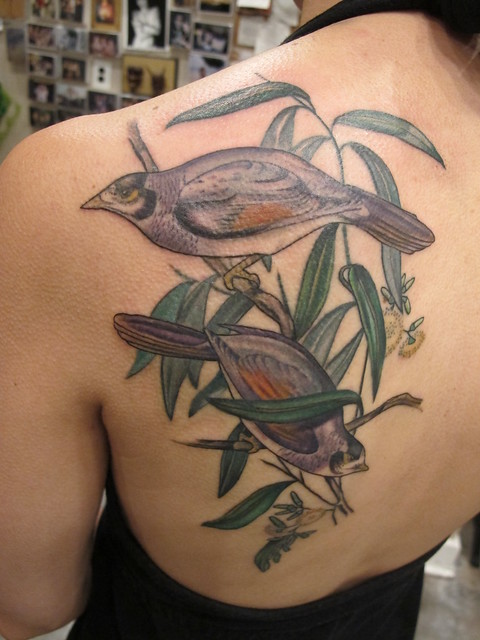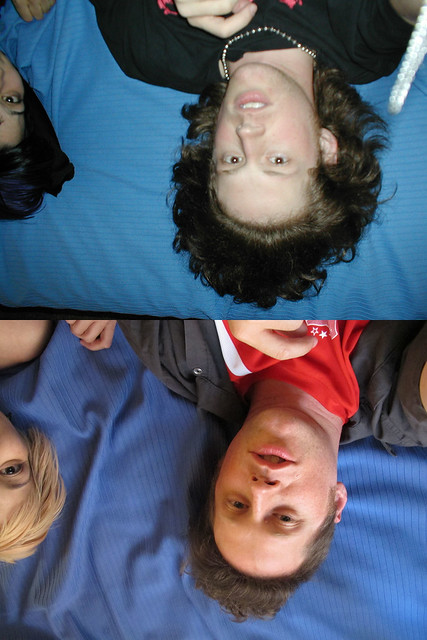I just sent out another edition of my e-mail blast, which has lots of lovely news in it, particularly recording news. You can read it here (and by the way, for the moment, you can subscribe to it here):
But for convenience's sake, here are some of the audiovisual elements:
Take note: Together is being performed TONIGHT at 8PM in Newport Beach, California, at the Choral Arts Initiative inaugural concert: details here.
You should also all go read this issue of Sound American, because I'm quite proud of having been interviewed, given the company I'm in.
###
On a completely different topic: they say tattoos are addictive.
Yeeeeaaah, maybe.
Last year, I got this done by Cindy at No Ka Oi Tiki Tattoo just south of South Street (I'm in her gallery too!):
You can read all about the significance of the image in these blog posts, but the short of it is that these are noisy miner birds as depicted in John Gould's The Birds of Australia. I've been thinking about getting something on my right upper arm for a while. I wasn't really sure what I wanted, or even if it would be similarly ornithological, but while doing some idle browsing on the topic of Gould this week, I came across some interesting information.
Edward Lear — yes, he of "Owl and the Pussycat" fame, though my favorite of his poems is "The Dong with a Luminous Nose" — was once an ornithological illustrator. In fact, John Gould employed Lear (without crediting him) for many years to help him with his publications, and Lear taught Gould's wife how to make the lithographs for Gould's works, and drew all of the backgrounds. Lear's own ornithological specialty was parrots; he would spend hours at the London Zoo's Parrot House drawing birds from life, including several Australian species. I sought out his lithographs, and I think they are breathtaking. Frankly, he is a far better artist than Gould or his wife. Here is a selection from his own book The Parrots, but this one is my favorite, which was included in The Natural History of Parrots by Prideaux John Selby (1836):
(I've cleaned up the colors and altered some of the background.)
When I was growing up in Queensland, one of my favorite zoo-type places to go was Currumbin Sanctuary, whose main draw is scheduled rainbow lorikeet feedings that attract hundreds and hundreds of birds, all happy to land on your head and shoulders for a taste of nectar. Later, in Sydney, I lived for a drunken period with far too many college friends in a two-bedroom third-storey apartment with a balcony. Every morning just after dawn, huge flocks of rainbow lorikeets would crowd the railing of our balcony and screech like it was judgement day. It was deafening. I still cringe to remember the effect on my poor hungover head. As much as I swore and threw objects in their direction at the time, I've missed them. The closest thing to such a striking bird here in Philadelphia is the cardinal, and they don't have nearly as much personality.
When Matt and I visited Australia again in 2006, I took him to Taronga Zoo, where the wild lorikeets are so tame they will perch on your hand at the cafe and go for packets of sugar.
They are so numerous and destructive in Australia that they've been designated a pest by the government (similar to the noisy miner — apparently I have a cheeky soft spot for native Australian birds that do the opposite of become extinct after urbanization). Despite this, I was shocked when I came to America and saw two rainbow lorikeets in a pet store in Central PA. They looked utterly miserable, huddled in a corner of their cage with dull feathers. It didn't seem right.
Anyway, I'll let the idea sit for a few weeks at least before I decide.
But for convenience's sake, here are some of the audiovisual elements:
Take note: Together is being performed TONIGHT at 8PM in Newport Beach, California, at the Choral Arts Initiative inaugural concert: details here.
You should also all go read this issue of Sound American, because I'm quite proud of having been interviewed, given the company I'm in.
###
On a completely different topic: they say tattoos are addictive.
Yeeeeaaah, maybe.
Last year, I got this done by Cindy at No Ka Oi Tiki Tattoo just south of South Street (I'm in her gallery too!):
You can read all about the significance of the image in these blog posts, but the short of it is that these are noisy miner birds as depicted in John Gould's The Birds of Australia. I've been thinking about getting something on my right upper arm for a while. I wasn't really sure what I wanted, or even if it would be similarly ornithological, but while doing some idle browsing on the topic of Gould this week, I came across some interesting information.
Edward Lear — yes, he of "Owl and the Pussycat" fame, though my favorite of his poems is "The Dong with a Luminous Nose" — was once an ornithological illustrator. In fact, John Gould employed Lear (without crediting him) for many years to help him with his publications, and Lear taught Gould's wife how to make the lithographs for Gould's works, and drew all of the backgrounds. Lear's own ornithological specialty was parrots; he would spend hours at the London Zoo's Parrot House drawing birds from life, including several Australian species. I sought out his lithographs, and I think they are breathtaking. Frankly, he is a far better artist than Gould or his wife. Here is a selection from his own book The Parrots, but this one is my favorite, which was included in The Natural History of Parrots by Prideaux John Selby (1836):
(I've cleaned up the colors and altered some of the background.)
When I was growing up in Queensland, one of my favorite zoo-type places to go was Currumbin Sanctuary, whose main draw is scheduled rainbow lorikeet feedings that attract hundreds and hundreds of birds, all happy to land on your head and shoulders for a taste of nectar. Later, in Sydney, I lived for a drunken period with far too many college friends in a two-bedroom third-storey apartment with a balcony. Every morning just after dawn, huge flocks of rainbow lorikeets would crowd the railing of our balcony and screech like it was judgement day. It was deafening. I still cringe to remember the effect on my poor hungover head. As much as I swore and threw objects in their direction at the time, I've missed them. The closest thing to such a striking bird here in Philadelphia is the cardinal, and they don't have nearly as much personality.
When Matt and I visited Australia again in 2006, I took him to Taronga Zoo, where the wild lorikeets are so tame they will perch on your hand at the cafe and go for packets of sugar.
They are so numerous and destructive in Australia that they've been designated a pest by the government (similar to the noisy miner — apparently I have a cheeky soft spot for native Australian birds that do the opposite of become extinct after urbanization). Despite this, I was shocked when I came to America and saw two rainbow lorikeets in a pet store in Central PA. They looked utterly miserable, huddled in a corner of their cage with dull feathers. It didn't seem right.
Anyway, I'll let the idea sit for a few weeks at least before I decide.


































